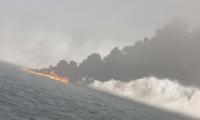groups led by Qari Ehsanul Haq and Mohammad Shamil will be working from the TTP platform as a unified force to advance the militant agenda of the jehadi conglomerate.”
Information acquired by security agencies suggest that after lying low for almost a year following the launch of the military operation in North Waziristan, Commander Matiur Rehman has reactivated himself at the behest of al-Qaeda to unleash a fresh wave of terror across Pakistan by reinforcing the TTP which is going through a rough patch now a days. The US Treasury Department had included Mati in the list of the Specially Designated Global Terrorists on December 2, 2010 for being a key al-Qaeda operational leader who had attempted to target American interests in Pakistan as well as abroad. The UN Security Council subsequently tagged him as a most wanted al-Qaeda linked terrorist on August 22, 2011 for taking part in the financing and planning some major terrorist activities, including the August 2006 failed plot to destroy mid air as many as 10 US-bound British aircrafts.
Matiur Rehman became the chief operational commander of the LeJ following the June 29, 2002 arrest of its Salar-e-Aala (operational chief) Akram Lahori - a graduate from the Punjab University Lahore and a former bodyguard of Maulana Haq Nawaz Jhangvi, the slain founder of the Sipah-e-Sahaba Pakistan (SSP). Mati is playing the same role as had been played by another key al-Qaeda-linked LeJ leader, Amjad Hussain Farooqi - coordinating with al-Qaeda top brass on behalf of Pakistani militants. Amjad Farooqi was killed by the security agencies in an encounter with the Sindh police in May 2004.
An expert in bomb making, Mati is closely linked to the January 2002 murder of the Wall Street Journal reporter Daniel Pearl, who was abducted and beheaded in Karachi. Therefore, there has been great concern in the US intelligence establishment about his terrorist network in Pakistan which often targets the western interests. The Americans believe that Matiur Rehman had assisted Adnanal Shukri Jumah, another key al-Qaeda leader who had planned to bomb trains in New York and London way back in 2009. Jumah was killed by the Pakistani security forces in December 2014 in a raid in South Waziristan. Mati became a most wanted FBI terrorist when his name surfaced in August 2006 during interrogation of one of the 17 suspects arrested in Pakistan in connection with the plot to blow up mid air 10 US-bound British jetliners. The plan was modelled after the 1995 Bojinka plot devised by al-Qaeda’s then chief operational commander Khaled Sheikh Mohammad and his nephew, Ramzi Yousaf.
Ramzi Yousaf was the prime accused in the New York World Trade Centre bombing of February 1993 and arrested from an Islamabad guesthouse on February 7, 1995. Khaled Sheikh was the mastermind of 9/11 terrorist attacks and arrested from the Rawalpindi residence of a Jamaat-e-Islami leader in March 2003. After Sheikh’s arrest, Mati started taking orders from al-Qaeda’s new chief operational commander, Abu Faraj Al Libbi, before he too was nabbed from the Mardan district of the Khyber Pakhtunkhwa on May 3, 2005. Mati reportedly manages al-Qaeda’s directory of tested fidayeens who have passed through terrorist training camps located in the largely lawless Waziristan tribal belt.
Described as extremely dangerous due to his role as the liaison between al-Qaeda and Pakistani jehadis, Mati comes from Bahawalpur. Americans describe him as someone who had helped train hundreds of fellow Pakistani militants at training camps during the late 1990s, being a key commander of the Harkatul Jehadul Islami (HUJI) who had also worked under Commander Ilyas Kashmiri, the slain chief of the Brigade 313 who was also the ameer of the Azad Kashmir chapter of the HUJI (who was killed in a US drone attack on June 4, 2011 in South Waziristan). Those trying to hunt down Matiur Rehman portray him as extremely dangerous due to his role as a crucial interface between the brains of al-Qaeda and its muscle which is mainly composed of militants from the Pakistani jehadi groups.
According to the Pakistani intelligence input, Matiur Rehman was last tracked down at Karman Hotel in the main Miranshah Bazaar of North Waziristan. He had stayed there along with his wife Gulshan and an infant daughter after, but abandoned the locality in 2011 after narrowly escaping an American drone attack. Subsequent intelligence reports said that he had travelled to Lahore the same year to attend a religious congregation, mainly to interact with his jehadi cadres and to formulate their future strategy. Analysts believe the merger of three jehadi outfits with TTP almost a year after the launch of the Waziristan military operation is a bad news for the Pakistan security establishment because the ameer of Jamaatul Ahrar Commander Omar Khalid Khurasani and the ameer of Lashkar-e-Islam Commander Mangal Bagh too had recently joined hands with the Fazlullah-led TTP.
Federal Minister for Religious Affairs & Interfaith Harmony Sardar Muhammad Yousaf looks on in a meeting on March 10,...
High Commissioner of Rwanda to Pakistan, Fatou Harerimana seen in this image. — APP/FileIslamabad:High...
The Pakistan Administrative Services pose for a group photo at the NUST main campus on March 10, 2025. —...
This screengrab taken on March 10, 2025, shows a Seminar on International Women’s Day organised by SDPI. —...
Cisco Pakistan country manager Faheem Anwar in a meeting with Ministry of Federal Education and Professional...
Federal Directorate of Education building. — APP/File Islamabad:The Federal Directorate of Education has announced...







